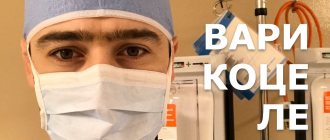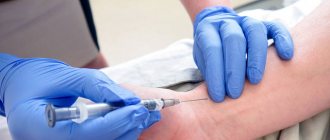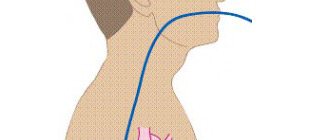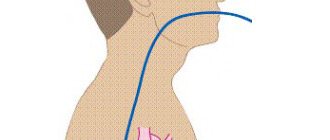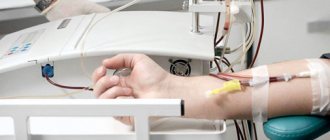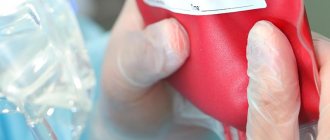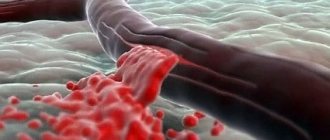Indications for surgery
Surgery to remove varicocele is indicated in the following cases:
- painful sensations in the scrotal organs;
- deviations in spermogram parameters;
- changes in the size and density of the testicle, identified as a result of an external examination or ultrasound diagnosis.
The timing of the operation is determined by the indications. In case of dilated vessels, it is better to perform the operation as quickly as possible, without waiting for complications. If there are no visible changes or discomfort, then surgical intervention can be postponed, supportive therapy can be used, and periodic monitoring can be carried out using ultrasound diagnostics.
The likelihood of developing male infertility
The time has passed when women were considered the main “culprits” of infertile marriages. According to modern data, more than 40% of cases of infertility in men are associated with dilation of the veins of the spermatic cord and testicles, and the prognosis worsens over time. Therefore, operations to eliminate varicocele should be performed at a young age. After successful treatment, the risk of testicular atrophy and infertility is significantly reduced. It is now possible to treat varicocele of any degree using endovascular surgery without incisions and pain, so you should not delay this treatment for a long time.
Contraindications
Varicocele surgery is not recommended in the following cases:
- period of puberty in a teenager. At an age when the body is rapidly developing, relapses are possible. In this case, the operation is recommended to be performed when the patient reaches 18 years of age;
- with an asymptomatic course of the disease and no complaints of discomfort from the patient. The operation may not be performed if the patient does not plan to become a father, for example in old age;
- with hemophilia and diabetes mellitus in a state of decompensation.
Strict contraindications are acute conditions in the abdominal cavity, such as appendicitis, peritonitis.
When is surgery necessary for varicocele?
Marmara surgery is recommended for the following indicators:
- Poor spermogram, which can cause infertility. In practice, operations are performed on all men who have even grade 1 varicocele if the couple wants a child.
- Pain in the scrotum area, which has a pulling nature and intensifies over time. Heaviness and discomfort in the testicle, increasing with walking and physical activity.
- Swollen veins that are easily palpable, which indicates the last stage of the pathology.
Mild varicocele does not affect the quality of life, is not accompanied by pain, and does not cause testicular atrophy, so surgical intervention is not always required. At the time of diagnosis of the pathology, the quality of sperm is not always impaired, so a man can conceive a child. Treatment is required at stages when there are already problems with the generative function, the man wants to preserve fertility in the future, even if no problems were identified at the time of the spermogram.
Preparing for surgery
Varicocele surgery in men is planned, so before performing it it is necessary to undergo a standard examination, which includes:
- general blood and urine tests;
- blood test to identify pathogens of genitourinary infections;
- blood biochemistry;
- coagulogram;
- ECG;
- spermogram.
Be sure to inform your doctor if you are allergic to any medications.
5–7 days before varicocele surgery, it is advisable to stop blood thinning medications. If they are prescribed for health reasons, you must inform your doctor about this.
During the consultation, ask the doctor all the questions you have about how the operation is performed, how long it lasts, and what the prognosis is in your particular case.
POSTOPERATIVE PERIOD
— To relieve pain after any operation for varicocele, the patient is prescribed analgesics; — to avoid the development of infectious diseases, antibacterial prophylaxis is carried out; — to be able to tension the spermatic cord, a special support bandage is required; - when suturing a wound with absorbable suture material, there is no need to remove the sutures, otherwise the sutures are removed after approximately nine to ten days; — over the next six months it is necessary to exclude heavy physical activity; — ultrasound control (Doppler examination) of the scrotal vessels after surgery for varicocele must be performed after 6 months; — if the indication for surgery for varicocele is infertility, you can plan conception immediately after the sutures are removed. If pregnancy has not occurred within 3 months after surgery for varicocele, it is necessary to perform a control spermogram and contact a urologist with the result.
Varicocele removal methods
Today, several types of surgical treatment of varicocele are practiced.
Classic varicocele surgery using the methods of Ivanissevich and Palomo. Veins are removed in an open manner through incisions measuring 3–5 cm. At the present stage of development of medicine, the methods are considered outdated. The only advantage is the low cost of the operation. There are significantly more disadvantages: a high risk of relapses and complications, a long recovery period.
Laparoscopic varicocele surgery through punctures, which is performed under general anesthesia. The punctures are almost invisible and heal quickly. The method has proven itself well in bilateral pathology. The risk of relapse is minimal.
Endoscopic sclerosis of the affected vessel is performed through a puncture in the femoral vein under the control of a microscope and an X-ray machine. The method is indicated for bilateral pathology, severe pain or asymptomatic disease. The recovery period is very short. The only drawback is the use of x-rays.
Microsurgical operation Marmara. The manipulation is performed under the control of an electron microscope (photo). It allows you to work only with the damaged vessel, without affecting other veins and lymphatic ducts. Today this is the most progressive method of removing varicoceles. It does not require long-term hospitalization, there is practically no recovery period, the incision heals very quickly, and the likelihood of relapse is extremely low.
Operation Marmara at the Urology Clinic of St. Petersburg State Medical University
We perform Marmara surgeries for patients over 18 years of age. Residents of St. Petersburg and other cities are accepted for treatment.
The operations are performed by Dmitry Sergeevich Gorelov:
- He has been performing the Marmara operation since 2009.
- Performed more than 400 such operations
- For 7 years he worked as an andrologist at the state Family Planning Center (infertility department).
What is the probability of relapse after Marmara surgery?
- The relapse rate after Marmara surgery is low and, according to the literature, less than 1%.
- The literature describes cases of scrotal swelling and testicular hydrocele due to damage to the lymphatic vessels.
- The result directly depends on the experience of the surgeon
- It is necessary to have high-quality microsurgical instruments and optics.
How long does treatment take:
- Operation on the day of admission or the next day
- The operation lasts about 1 hour, under local anesthesia
- Discharge the next day after surgery
- Dissolving stitches do not need to be removed
- Dressings are carried out free of charge
How is the treatment carried out?
Medicinal and surgical methods are used. The latter are considered the most effective. There are many types of surgical interventions. One of the most effective is to ligate the testicular vein. Currently, minimally invasive surgical correction has become popular: blood flow through the vessel is stopped using a special plug. Laparoscopy is effective, during which the vessels are excised on both sides.
In the first degree of pathology, the patient is recommended conservative therapy and given recommendations:
- Wear underwear;
- Take a contrast shower;
- Go swimming.
The second and third degrees are treated surgically. There are three main types of operations:
- Traditional open;
- Endoscopic;
- Endovascular.
Currently, laparoscopic and endovascular correction techniques are becoming increasingly popular. The goal is to stop the pathological blood flow by ligating the testicular vein.
The following surgical procedures are performed on adolescents.
- Laparoscopic surgery
This intervention method is minimally invasive and uses general anesthesia. No long-term rehabilitation is required. Full recovery is achieved within a month.
- Microsurgical
The safest and most effective method. Advantages:
- Lowest number of relapses;
- Painless;
- Minimal trauma;
- No need for hospitalization.
- Endovascular technique
Vein embolization is performed through a puncture of the thigh vein.
Predicting the results of treatment
The effectiveness of laparoscopic surgery has been proven by the fact that patients return to a full active life after a short period of rehabilitation. Up to 90% of men gain the opportunity to become fathers. The qualitative composition of sperm is restored, sperm become mobile, and their number increases.
The main condition for operated patients is compliance with the rules of the recovery period and careful monitoring of their well-being.
In cases of unpleasant or painful sensations, you should immediately visit a doctor. Signs of concern may include:
- change in the size of the scrotum;
- pain symptoms in the scrotum area;
- body temperature above 37°;
- painful sensations when urinating.
Statistics on common treatments
The effectiveness of various approaches can be learned from the results of numerous studies. Laparoscopy is characterized by an effectiveness of 85% with a frequency of secondary occurrence of pathology at the level of 5-15%. Treatment according to Ivanissevich with a probability of 3% will lead to the formation of hydrocele of the testicular membranes, with a frequency of 2-36% hydrocele will occur, and in 9% of men there will be a relapse. Sometimes patients' lymphatic vessels are damaged during the intervention.
Only through microsurgical manipulation can a 100% recovery be achieved without the threat of relapse and unpleasant side effects. Within a year and a half, patients' sperm concentration is restored by 38-52% and their motility by 17-75%, the parenchymal mass of the testicle increases by 7-8%, and pain is eliminated. If the couple had problems with childbirth, then pregnancy occurs already by 9-12 months after the manipulation. The time to completely restore normal blood flow and return a man to his usual way of life is up to three weeks.
Laparoscopy technology
Stages of surgical procedures:
- administration of general anesthesia;
- three trocars (tubes through which instruments are inserted) are installed into the peritoneal area through punctures;
- through a Veress needle, the cavity is filled with carbon dioxide (this improves the movement of instruments);
- a laparoscope is inserted through one trocar, the others serve to provide access for surgical instruments to the required area;
- dilated veins are isolated, ligation and excision of diseased areas are carried out, the flow of blood in the affected vessels is stopped;
- the instruments are removed, and an aseptic bandage is applied to the puncture sites.
The laparoscopic revascularization operation lasts from 45 minutes to one hour.
Laparoscopy: advantages over classical operations
The laparoscopy operation is performed using a modern device - a laparoscope. It is equipped with a special video system. When inserted through small punctures in the scrotum, the equipment displays a greatly enlarged image on the monitor.
The method of laparoscopic surgery has a number of advantages over traditional operations. It is characterized by:
- low likelihood of infectious complications;
- high precision of surgical actions;
- low degree of injury and blood loss;
- the ability to diagnose additional varicose veins;
- short recovery period;
- absence of postoperative pain syndromes;
- restoration of sexual functions within seven days;
- the ability to examine other organs of the peritoneum;
- absence of scars and cosmetic defects.
The laparoscopy method is successfully used to remove varicoceles on both sides.
Despite the large number of advantages, the technique has disadvantages. For the most part, they are associated with the dependence of surgical actions on the technical equipment used. If the video system malfunctions, a situation may pose a threat to the patient's health. Also, the disadvantages of laparoscopic intervention include:
- the use of general anesthesia, which sometimes causes side effects in patients;
- higher price compared to classical operations;
- possible relapses (occur very rarely, in approximately 3% of cases).
